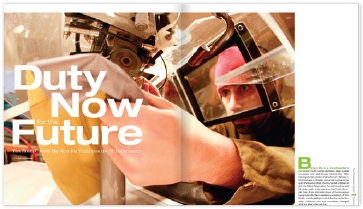Feature w/Chris Ankeny
Issue 5.2
8 Pages, 6, 427 Words
Tom Routh had been a friend for a number of years, but his resume of achievement for companies such as Arc'Teryx, Cirqueworks, Dana Designs and Salomon was not well known. Diving into the mindset and misty design studio in Pemberton, BC, my interview elevated his impact to public view.
Link to Full Story
Birken, BC is a snowboarder’s paradise: north-country seclusion, deep coastal snowpack and sled-access backcountry. After braving Olympic-scale construction on Highway 1, SUV backups in Whistler, and a final cocktail at the gritty Pemberton Hotel, the tiny hamlet of Birken is still one Native Reservation, five rail crossings and 25 clicks north. A tiny speck on the Coast Mountain map. A few kilometers short of the snowplow turnaround sits the in-residence workshop of Tom Routh, snowboarding’s most influential under-the-radar craftsman who has completely changed what we wear when we ride.
Routh’s Birken compound stands in striking contrast to its off-grid location. His FYI design studio is stocked with cutting-edge technology: seam-taping, laser-cutting and digital patternmaking equipment. Industrial sewing machines, high-temperature presses and cutting tables fill the square footage. Rolls of next-gen fabric are shelved in bulk, while zippers, buckles and swatches compete with piles of prototype packs, decade-old samples, and current prototypes for storage space. While some of his peers barely require even a basic tool kit for their sketch-and contract work, Tom’s hands-on method demands the horsepower of a fully stocked shop.
While some recoil at bringing work home, Routh has always maintained close proximity to his interlinked passions of riding and design. At Cirqueworks–the pack company he started at age 23 with Laura Metzler–Routh took up residence in a small room off the shop while honing his radical designs and seeing his operation run dry of cash. When he moved on to Salomon’s Design Center, Tom baffled the corporate folk by showing up with a semi-trailer full of sewing machines—and an ’85 Volvo packed with personal items. Then, when recruited to launch Arc’teryx into snowsports, he crammed an 8-foot-square cutting table into his cramped Vancouver loft to burn the midnight oil while refining his revolutionary curved-zip shell. After Arc’teryx sold to Salomon, Tom checked out, headed north and opted for the free hand of freelance, settling on a location with a workspace 20 steps from home.
This intense personal investment has defined his work. Each round, the cyclical outcome has been both total exhaustion and pure brilliance. But, ultimately, he chooses to let his products get the glory. His patented Cirqueworks pack design changed how we haul boards up the bootpack and was copied–both with and without permission–by many major brands. His Arc’teryx Descent line–which pioneered innovations such as sublimated branding, laminated radio pockets, rolltop packs, two-textile hybrids and the curved zipper–collected outstanding reviews and became an on-hill sensation that catalyzed a dramatic shift toward clean and technical style.
Does the Standard Cycle of One-Season Product Cycles, Illustrator-Only Design and Offshore Production Limit the Potential of Design?
Absolutely. If the designer doesn’t know how to build the garment, it’s hard for them to design a good garment. Just like an architect that doesn’t know how to build a house isn’t going to be a very good architect. There are not many designers out there who are product users and also build the stuff they make. That’s kind of frustrating because with the factory team offshore nobody’s learning anything about the products they sell because they are cut off from the factory. You learn while you’re trying to design the garment physically and to build the garment physically, you don’t learn by drawing a picture of it on a piece of paper.
Anything that Concerns You About the Current State of the World?
Wow.
Top Three?
George Bush: number one, Peak Oil: number two, and the collapse of the US dollar: number three.
Pretty Much Sums it Up?
Pretty well, yeah. OK, no, wait–even the biggest thing of all would be global warming. What the hell–we were sitting out here in March wearing shorts and flip-flops. Is this a fluke or is this a glimpse of where we’re headed that actually has implications beyond George Bush, oil and the dollar? What the hell do you do if it is reality, what does that mean for the future of snowsports? You can only go so far north and we’re already pretty far north and it’s not so good. So, that’s a fourth thing that could have implications far beyond politics and natural resources. Maybe that’s the biggest one and it’s just a longer-term one than George Bush, oil and the collapse of the dollar. But it’s pretty much in our face.
Last Question: Girl, Job, House, Car–Looks Like You’ve Got it all Dialed?
Yeah, but I still need an RS4 Avant. I’ll call you as soon as I hook it up.